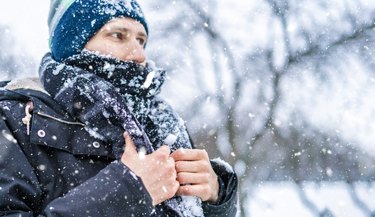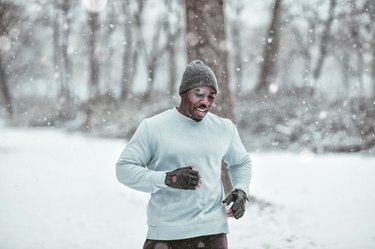
Does being cold burn calories? Yep. But before you plunge into the nearest snowbank for some no-effort calorie-burning, it's important to weigh the pros and cons of getting cold on purpose.
How Many Calories Does Being Cold Burn?
Depending on how low your body temperature gets, being cold can increase you energy expenditure (aka calories burned) by approximately 48 percent, according to a small February 2014 study in Cell Metabolism.
But seeking out cold is not an effective or healthy weight-loss strategy.
Video of the Day
How Being Cold Burns Calories
When you get cold, your body has two main ways to produce heat: shivering and non-shivering thermogenesis, says Zac Schlader, PhD, associate professor in the School of Public Health at Indiana University Bloomington. So, does shivering burn calories?
Video of the Day
"Non-shivering heat generation typically occurs before shivering starts [i.e., at lower reductions in body temperature] and is believed to be due to the activation of brown adipose tissue," Schlader says.
The interest in brown fat activation comes from the fact that brown fat burns calories in order to produce heat. It may even use other body fat as fuel to burn those calorie, according to the Mayo Clinic.
"But the increase in energy expenditure with non-shivering heat production is relatively limited compared to shivering," Schlader says. Essentially, shivering burns more calories than non-shivering heat production.
As you get colder, there's an inverse relationship between temperature and calories burned. "Once your body temperature starts to fall, the more calories you burn until you have reached maximal shivering," he says.
When you shiver, muscles contract and loosen in quick succession to raise the body's core temperature. In doing so, brown fat tissues are activated and the calorie-burning process begins. Shivering also triggers the production of a hormone known as irisin, the same hormone produced by exercise, according to the Cell Metabolism study.
During that study, participants who rested under cooling blankets experienced a 48 percent increase in energy expenditure (aka calories burned). And those who were cold enough to shiver experienced an 88 percent increase in muscle activity, compared to the 13 percent increase of those who didn't shiver.
Having said all this, do you burn more calories in the heat? Yes, you do, thanks to your heart pumping blood at a faster rate to keep muscles oxygenated.
Shivering vs. Exercise for Weight Loss
Sure, being cold burns calories. But getting chilled isn't an effective (or necessarily safe) way to lose weight.
"Just because you can burn more calories by being cold, it doesn't mean it is the best way to burn additional calories, especially considering that being cold is uncomfortable," Schlader says. "Plus, the increase in energy expenditure with non-shivering heat production is quite modest compared to, say, exercise." Think: 50 to 100 calories per day from the cold vs. 100-plus calories with exercise)
The American Council on Exercise notes that working out, by itself, is usually enough to raise the body's core temperature to a comfortable level in lower temperatures.
If you're trying to lose weight, extreme cold can actually impede your progress. One obvious reason is that it's hard to find the motivation to even step outdoors, let alone try to ramp up your metabolism for the day.
When you do go out in low temperatures, not preparing for the conditions can make you too uncomfortable to workout for very long. Of course, it also leaves you vulnerable to chills, frostbite and hypothermia. Make sure to dress in layers — preferably with inner layers that use materials designed to wick moisture away from your skin while guarding you against the elements.
If the temperatures aren't too extreme, your workout performance may improve, allowing you to burn more calories each time, according to the American Heart Association (AHA). Without the risk of humidity and high temperatures to worry about, you may feel comfortable enough to walk, skate or go for a run for a longer period of time.
- Mayo Clinic: "What Is Brown Fat?"
- American Council of Sports Medicine: "Safety Tips for Exercising Outdoors"
- American Heart Association: "Cold Weather Fitness Guide"
- Cell Metabolism: "Irisin and FGF21 Are Cold-Induced Endocrine Activators of Brown Fat Function in Humans"
- Medicine and Science in Sports and Exercise: "Irisin Does Not Mediate Resistance Training–Induced Alterations in Resting Metabolic Rate"
- Metabolism: "Irisin in response to acute and chronic whole-body vibration exercise in humans"
- American Council on Exercise: "Do I burn more calories when it is hot outside or cold?"


